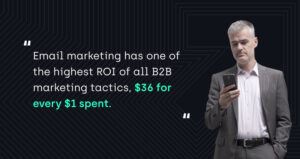Email marketing has one of the highest ROI of all B2B marketing tactics, $36 for every $1 spent. We’ve gathered 24 best practice tips for email marketing to increase reader engagement and improve conversions to leads in the B2B tech space. Part 1 covers the first 12 tips, which focus on your recipients, your subject line, and your credibility. Enjoy!

“Who” Matters Most
1. Bad email lists kill campaigns.
If you are sending to the wrong people nothing else you do will matter. It sounds obvious, but it is the most common problem with failing email marketing.
2. Keep your list clean.
Sometimes users provide false emails or switch companies and no longer use the email you have in your database. To avoid high bounce rates, run your list through a hygiene cleaner such as Neverbounce to ensure that the emails you have are legit, accurate, and active.
3. Scrutinize your contacts thoroughly.
Sometimes users provide false emails or switch companies and no longer use the email you have in your database. To avoid high bounce rates, run your list through a hygiene cleaner such as Neverbounce to ensure that the emails you have are legit, accurate, and active.
4. Manually check your list for errors.
Invest the time to eyeball your list, especially if it came from the sales team or an external source. Be sure that there isn’t incorrect data in the list, such as a phone number or company website where the email should be.
Strengthen Your Subject and Preview Text
5. Never use the word “free”.
In fact, never use any spam trigger word. There is an entire list of spam trigger words to avoid in your subject lines (thanks, HubSpot). Your subject should intrigue the sender without using suspicious words like “free”.
6. Articulate a succinct offer.
Think carefully about the value of what you are offering, and put it clearly and succinctly in the subject line. The recommended length of subject lines is 7-9 words or 60 characters max.
7. Don’t be misleading.
Don’t trick recipients into opening by using misleading subjects. Tell them exactly what they will get, in an interesting way. Concepts that work well are questions, numbers, and words that indicate the type of asset you’re sharing (such as infographic, chart, etc.) if applicable.
8. Remember the preview text.
Preview text isn’t visible in all inboxes, but for those who can see it, it provides another chance to see what an email is about before opening. For marketers, it’s additional real estate to convince recipients to click. Preview text is longer than the subject, between 60-100 characters. Place the most impactful words at the front to avoid truncation.
Your Credibility in 5 Seconds
9. Your sender must be a credible source.
Your message should come from a source that the recipients trust or care about. We recommend using the name and email of an actual employee, rather than a general company address like info@yourcompany.com.
10. Get email sender authentication.
Email authentication is a series of technical processes that allow inboxes to verify that your email is coming from who it claims to be coming from, in order to prevent phishing and spam. The three most common authentication standards are SPF, DKIM, and DMARC.
11. Don’t be misleading (yes, again!)
Upon opening, users assess your email’s legitimacy in 4-5 seconds. Your copy must match the expectations that the subject line set up, and your CTA must deliver on the offer that was promised. Humans innately want to discredit and delete- don’t give them a reason to!
12. Use design to communicate, not for pure aesthetics.
In those 5 seconds, users are also assessing if your email looks and feels trustworthy. Use colors to accentuate your brand and imagery that aligns with the greater campaign this email is a part of. Make the design eye-catching but keep it professional; if it’s overwhelming or excessive, the user will trash it immediately.
At this point, we’re sure you can tell that executing a successful B2B email marketing campaign is no mindless effort. Next time for Part 2, we’ll be diving into the final 12 best practices for email marketing, focusing on the email’s value, accessibility, and CTA. See you then!

